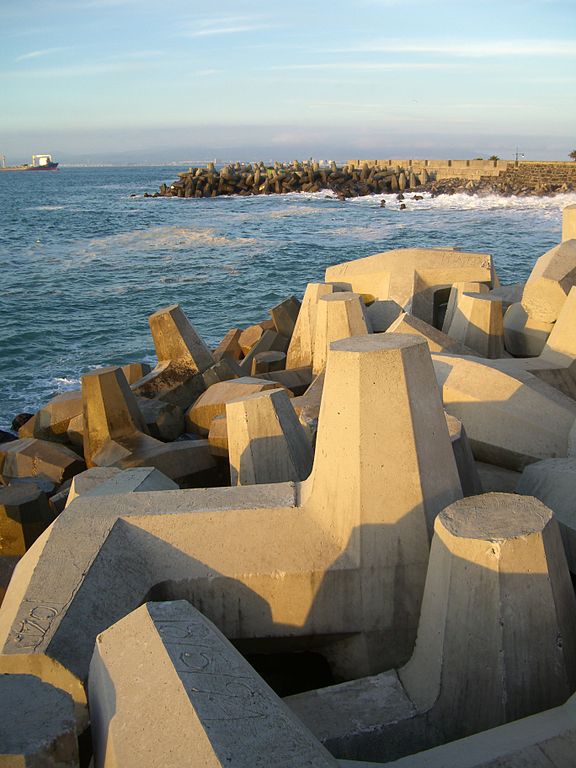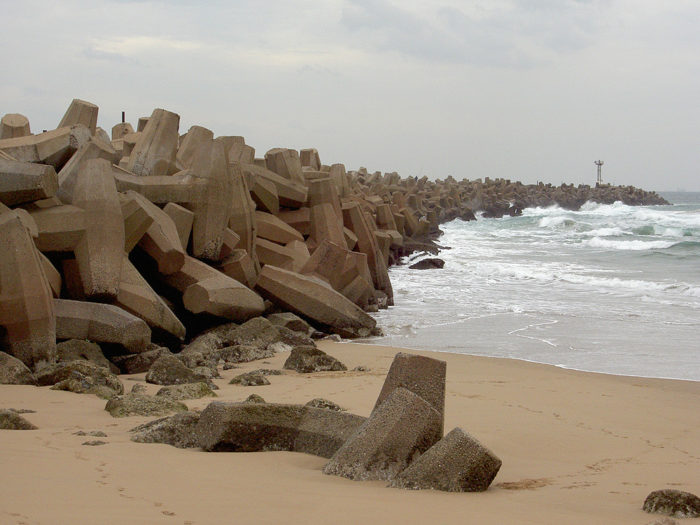Dolosse are nondescript reinforced concrete blocks that are scattered across coastlines all over the world. The blocks, which can weigh up to 88 tonnes, have an odd shape that allows them to interlock and when they are used in great numbers they protect breakwaters, groynes and harbours walls from the erosive force of the sea.
The first dolos was created in 1963 and it is a proudly South African invention. It was initially called “the Merrifield block”, according to Popular Mechanics, after one-time Port of East London System Harbour Engineer, Eric Merrifield. However, in later years Merrifield’s claim has been superseded by Aubrey Kruger, who was a young draughtsman working at the port at the time.
Before dolosse were invented, large rocks and concrete blocks were the most common form of coastal protection in the east of the country, according to the Mercury. These massive blocks, however, could be easily washed away or displaced.
As the story goes, after a storm in 1963 caused severe damage to the Eastern Cape’s coastline, Merrifield pondered if the breakwater would have been more resistant to the forces of nature if it was porous instead of bearing the full brunt of the force on one solid plane. The ideal protection was something that was cost-effective and would remain in place while dissipating the force of the waves.

This is where Kruger enters the picture. Depending on which account you believe, Merrifield then gave rise to the invention by discussing the design of a concrete structure with the young draughtsman or by instructing him to design it.
“The draughtsman, 28-year old Aubrey Kruger, was a modest, quiet local man who rode to work every day on a red Vespa scooter from his home in Cambridge, one of East London’s suburbs,” says the Mercury.
When Kruger went home for lunch on the day of the discussion, the first thing he apparently did was cut three pieces of wood from his wife Daphne’s broom.
He created a prototype by nailing the wood together in the shape of an ‘H’ with one twisted leg.
Both of Kruger’s children — his daughter Sandra, to the Mercury and his son Lance, to DispatchLIVE — say that their father based the design on the dubbeltjie thorn.
“He based it on the dubbeltjie thorn. Then he went back to work and put it on Mr Merrifield’s desk,” said Lance.
The children say that their grandfather, Joseph Kruger, who worked at the harbour’s dry dock as a carpenter, gave the invention its name.
“He came into Merrifield and dad’s office and said: ‘Ek sien julle speel met dolosse’,” said Lance. “Dolosse were joint bones children used to play with and that’s how they were named.”
In the past, children used to play with these crude bone toys and pretend that they were a team of oxen pulling a wagon.
Dolosse were, in theory, meant to be placed in front of, and on top of, each other along the breakwater where they would eventually interlock as the waves crashed against them.
With time the structures would fit snugly but still allow some of the waves to pass through gaps, which would weaken their erosive powers.
The designs of the first dolos were completed in 1963 and were based on the shape of the wooden prototype made by Kruger. Merrifield, as port engineer, was responsible for managing the project and signing off all plans, according to the Mercury.
In 1964, the first dolos was laid on the port breakwater. Kruger and his family were very proud of the invention and when he was transferred to Durban in 1966 he was presented with a copy of the amendment to the design — dated July 12, 1966 — signed by Merrifield, as a parting gift.
While Kruger never formally received credit for the invention, Merrifield accepted the Shell Design Award and the Associated Science and Technology Societies of South Africa’s Gold Medal, which hurt Kruger.
Sandra says that her father believed the invention to be the property of the South African Railways & Harbours (now Transnet), as it was developed on company time, which has been suggested as one of the reasons why the design of the dolos is not patent protected.
Kruger’s contribution to the design was eventually recognised — shortly before his death in 2016 — when the South African Mint created a coin that commemorated the Dolos as part of its South African inventions theme.
The coins, a R2 crown and a 2½ cent ‘tickey’ displayed a series of dolosse and three miniature silver dolosse.
“The dolos was developed by East London harbour engineer Eric Mowbray Merrifield and draughtsman Aubrey Kruger, whose images are both included on the coin,” said Richard Stone, the SA Mint product developer.
Kruger family was with him on the day the coins arrived from the Mint. His son Lance described it as an emotional occasion.
“We were all in the room when we gave him the coins and he got to touch them. He held them tight. We knew he was deteriorating and it was exciting to give this to him before he left us.”
Picture/s: Wikimedia Commons

